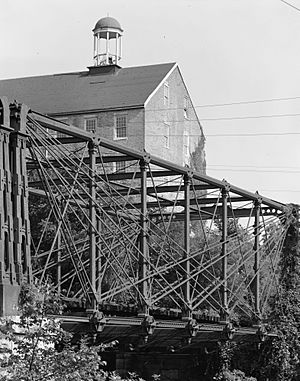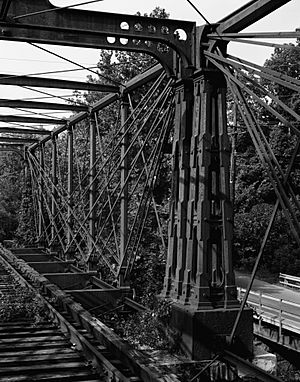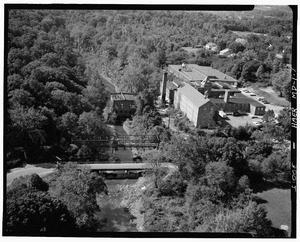Bollman Truss Railroad Bridge facts for kids
Quick facts for kids Bollman Suspension and Truss Bridge |
|
|---|---|

Bollman Bridge with Savage Mill tower in background, 1970
|
|
| Coordinates | 39°8′5″N 76°49′31″W / 39.13472°N 76.82528°W |
| Carries | Savage Mill Trail |
| Crosses | Little Patuxent River |
| Locale | Savage, Maryland |
| Characteristics | |
| Design | Bollman Suspension Truss |
| Material | cast and wrought Iron |
| Total length | 160 feet (48.8 m) |
| Longest span | 2 × 80 feet (24.4 m) |
| Number of spans | 2 |
| Piers in water | 1 |
| Load limit | 36 tons (72000 kips) |
| History | |
| Designer | Wendel Bollman |
| Construction end | 1869 |
The Bollman Truss Railroad Bridge is a really special bridge in Savage, Maryland. It's the only one left of its kind! This bridge shows a big step forward in how bridges were built in America.
It's a huge bridge, about 160 feet (48.8 m) long. It's a mix of two types of bridges: a suspension and a truss. The bridge you see today isn't the very first one built here. This specific bridge was actually built in 1852. It was then moved to this spot about 30 years later.
This makes it one of the oldest iron railroad bridges still standing in the United States. Today, trains don't use it. Instead, it's part of the Savage Mill Trail. People can walk or bike across it over the Little Patuxent River.
The Bollman design was the first successful all-metal bridge used by railroads. It was named after its inventor, Wendel Bollman. He was a civil engineer from Baltimore. Bollman started two companies to sell his bridge design. They built bridges all over North and South America.
In 1966, the American Society of Civil Engineers honored the bridge. They called it the first-ever Historic Civil Engineering Landmark. It was also added to the National Register of Historic Places in 1972. Later, in 2000, it became a National Historic Landmark. This means it's super important to American history.
Contents
History of the Bollman Bridge
This bridge was first built in 1852 for the Baltimore and Ohio Railroad. We don't know exactly where it was first used. In 1887, it was moved to its current spot. It crosses the Little Patuxent River near the Savage Mill.
The railroad line to Savage Mill started around 1840. It used to have a stone arch bridge. But changes at the mill in the 1880s needed a new bridge. So, the Bollman bridge was brought in.
The bridge was used until the mill closed in 1947. Train crews would add extra cars to avoid crossing the bridge with heavy locomotives. This meant they never needed a stronger bridge. A smaller road bridge was next to it, but it was removed after World War I.
The Bollman design was the first all-metal bridge widely used by railroads. It used wrought iron for pulling parts and cast iron for pushing parts. This was a big improvement over wooden bridges. Each part was strong on its own. This made the whole bridge less likely to fail.
Wendel Bollman patented his design in 1852. His company built about 100 of these bridges until 1873. They were strong and easy to put together. This helped American railroads grow quickly. Another Bollman bridge, the Wills Creek Bollman Bridge, still exists. But it uses a different design.
What Makes the Bollman Bridge Special?
The Bollman Bridge has two main sections, called spans. It sits on strong granite supports at each end. There's also a granite support in the middle of the river. The bridge's frame is made from a mix of wrought and cast iron.
This special design was patented by Bollman in 1852. Each section is about 79.5 feet (24.2 m) long. It's also about 25.5 feet (7.8 m) wide and 21 feet (6.4 m) tall. The Bollman design hangs the bridge deck from many strong metal rods. These rods handle the pulling forces. The top part of the bridge handles the pushing forces. This is why it's called a "suspension truss."
Bollman himself described his design as a "suspension and trussed bridge." This is because it doesn't have a lower chord like a typical truss bridge. Later, people just called it a "suspension truss."
The bridge also has cool decorations. The vertical parts look like Doric columns. The cast iron towers at the ends are also very detailed. A fancy metal cover on top of the towers was once lost. But it was replaced during a restoration project.
Metal signs at each entrance tell its story. They say "W. BOLLMAN, PATENTEE," "BALTIMORE, MD.," "BUILT BY B&O R.R. CO.," "1869," and "RENEWED 1866." New copies of these signs were put up during the restoration.
The bridge was originally painted in three bright colors. The towers and thick parts were red. The lighter, hanging parts were ivory. The exact shades are not known today.
Restoring a Historic Landmark
As mentioned, the American Society of Civil Engineers named this bridge a Historic Civil Engineering Landmark in 1966. It was also added to the National Register of Historic Places in 1972. Then, in 2000, it became a National Historic Landmark.
In 1978, experts checked the bridge for restoration. They found that parts of the floor were worn out. A big project to fix the bridge started in 1982. The bridge was restored by Wallace, Montgomery & Associates, LLP, in 1983. This was for the Howard County Department of Recreation and Parks.
More work was done later to keep it in good shape. It was rededicated on September 16, 2000. Today, the bridge is regularly cared for as part of Savage Park. Even the nearby Bollman Bridge Elementary School is named after this famous bridge!
Images for kids











